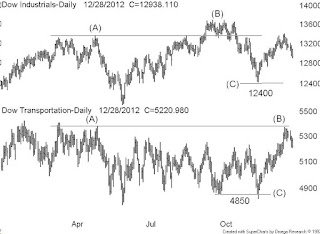This
is a portion of an annoying item that appeared in the Globe ROB
PAUL BRENT - Special
to The Globe and Mail - Published Thursday, Oct. 04 2012
Quote:
“the chart and data-heavy approach of Peter Gibson, CIBC’s top-ranked head of
portfolio strategy and quantitative research, provides both a guide to
portfolio balancing and market timing.
The
basis of CIBC`s asset allocation strategy is deceptively simple. Since 1998,
every time bond yields fall, stock prices fall, and every time bond yields
rise, in general, stock prices also rise in lockstep. What CIBC tries to do is
predict the ceilings for the 10-year U.S. treasury bonds.
“The
bond yield ceiling right now is 3.65 [per cent],” Mr. Gibson said. “If the
bonds were to rise to that level then the stock market becomes overvalued and
then we have to switch our exposure back into bonds.”
CIBC
used this analysis to detect and act upon a buy signal for equities in 1998, a
sell signal at the beginning of 2000 during “the peak of the tech mania,” a buy
signal in October, 2002, and a sell signal again in June, 2007. CIBC also sent
out a buy signal in January of 2009, but “we were a little bit early,” he said.
What’s
important about the years 2000 and 2007, when the markets crashed, “was that at
the same time we were hitting the ceiling for bond yields, suggesting that bond
yields are too competitive with stocks. We also have falling profitability
because the Fed is tightening, trying to stop the bond yield from rising,” Mr.
Gibson explained.
“So
the return on investment begins to fall, meaning bond yields are too
competitive and corporate profitability is falling,” he said. “You have no
business being in the stock market.”
The
result was two stock market collapses of roughly 50 per cent. Meanwhile,
because bond yields were falling, bond prices rose and bond total returns rose
37 per cent while the market fell 50 per cent. In 2007-2008, the bond total
return was up 20 per cent while the stock market was down 57 per cent.
“This
is how we time the market,” Mr. Gibson explained.
“By
switching just five times, from 1998 to 2009 – stocks, bonds, stocks, bonds,
stocks – you are doing almost an 18 per cent per-annum return” in Canada, with
a rotating split between 100 per cent stocks and 100 per cent bonds, Mr. Gibson
said. “Basically you could play golf the rest of the time. It is because first
and foremost you have this positive correlation between bond yields and stock
prices.”
Stock
picking is less important with this strategy, given that 60 per cent of a total
return from individual stocks is a function of the market rising or falling,
not a stock`s fundamentals, CIBC states.
Today,
CIBC’s data shows “right now the stock market is incredibly cheap, based on the
level of interest rates,” he said, and CIBC is recommending that investors
should be overweight in stocks.
CIBC
had noticed in recent months that corporate profitability was beginning to fall
and predicted (rightly) that a co-ordinated program of quantitative easing
would occur in the Europe, China
and the United States.
“That
is what has lifted this market,” Mr. Gibson said. “It is due to a policy shift,
though. It is not due to strong and sustainable profit growth. If I had
sustainable profit growth with the interest rate picture that I have, I would
probably be talking about 1700 on the S&P.”
End
Quote:
Now
– back to reality. Aside from the arrogant insinuation that the “big boys” are
smarter than us “small boys”, market timing implies that investors should dump
their investments when they get a “sell” signal from some seasonal or black box
strategy and then buy them back when a “buy” signal is generated. In the
example of the CIBC model
Mr.
Gibson says “every time bond yields fall, stock prices fall, and every time
bond yields rise, in general, stock prices also rise in lockstep”.
There
is also one minor problem with the Gibson / CIBC timing model. If Peter Gibson only
joined CIBC in 2009 how could he be a component of any CIBC model buy and sell
signals from 1998 through 2009?
I
display a long term monthly data plot of the 10-year U.S. treasury bonds above the
S&P500 and I have marked the CIBC buy & sell signal with up & down
arrows. Note the 1992–1998 period where the relationship failed and note the
2010–2012 period where the relationship also failed.
This
timing model needs two things to work, firstly the yield vs. S&P500 signals
has to be a fact (which is questionable) and secondly you need to get the yield
(upper plot) buy & sell calls right as marked by those up & down
arrows. Are we to believe the CIBC got all those yield calls right? A posted
comment sums it all up: gazous - 1:32 PM on October 4, 2012 - easy enough,
after the fact....






















